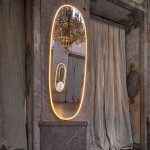What Hooks to Use to Hang a Mirror
Hanging a mirror securely and safely requires choosing the appropriate hooks for the job. Selecting the wrong type of hook can lead to damage to the wall and, more importantly, a fallen mirror. This article outlines the various types of hooks suitable for hanging mirrors and the factors to consider when making a choice.
Weight Capacity
The most crucial factor in choosing a mirror hook is its weight capacity. Always check both the weight of the mirror and the weight limit of the hook. Choose a hook with a weight capacity exceeding the mirror's weight to provide a safety margin. This prevents accidental falls due to slight shifts or vibrations.
Wall Type
Different wall types require different hooks. Drywall, plaster, concrete, and brick all have varying densities and load-bearing capacities. Using the wrong hook for a specific wall type can result in instability and damage. Always consult packaging guidelines to ensure the hook is suitable for your wall material.
Mirror Backing
The type of backing on the mirror influences the hanging method and the type of hook required. Some mirrors have D-rings or wire attached, while others have a smooth, flat back. The hanging hardware will dictate which type of hook is compatible.
Types of Hooks for Hanging Mirrors
Several hook options are available for hanging mirrors, each with its advantages and disadvantages:
Heavy-Duty Picture Hooks
These hooks are designed for heavier items and are ideal for large, heavy mirrors. They typically use nails or screws for installation and offer a robust hanging solution for drywall and plaster walls. Weight capacity varies, so it's important to select a hook appropriate for the mirror's weight.
Adhesive Hooks
Adhesive hooks offer a damage-free hanging solution for lighter mirrors. They adhere to the wall using a strong adhesive and are suitable for non-porous surfaces like tile and glass. Ensure the adhesive hook is specifically designed for mirrors and has a weight capacity sufficient for the mirror's weight. However, these are generally not recommended for heavy mirrors or textured walls.
Mirror Clips
Mirror clips grip the edges of the mirror and are secured to the wall with screws. They offer a secure hold and are suitable for frameless mirrors. Choose clips that are appropriately sized for the thickness of the mirror.
D-Ring Hangers and Wire
Some mirrors come with D-rings or wire attached to the back. In this case, the appropriate hook will depend on the hanging hardware. D-rings can be hung on picture hooks or screws, while wire can be hung on picture hooks or specialized wire hangers.
French Cleats
French cleats provide a strong and stable hanging system for heavy mirrors, especially for large or oversized ones. They consist of two interlocking pieces of wood, one attached to the wall and the other to the back of the mirror. The angled design provides a secure grip and distributes the weight evenly.
Toggle Bolts
For hanging heavy mirrors on hollow walls or drywall, toggle bolts offer a secure solution. These bolts expand behind the wall, providing a strong anchor point.
Considerations for Different Wall Types
Choosing the correct hook also requires understanding the nuances of different wall types:
Drywall
Drywall is a common wall material but is relatively soft. For lightweight mirrors, adhesive hooks or small picture hooks are often sufficient. For heavier mirrors, heavier-duty picture hooks, toggle bolts or wall anchors are necessary to provide adequate support.
Plaster
Plaster walls are generally stronger than drywall. Picture hooks and specialized plaster screws can be used for hanging mirrors. For heavy mirrors, consider using wall anchors or toggle bolts.
Concrete and Brick
Concrete and brick walls require specialized masonry anchors and screws. Drilling is required for installation. Ensure the drill bit and anchor are appropriate for the wall material.
Ensuring Secure Hanging
After selecting the correct hook, proper installation is crucial for safety and stability:
Accurate Placement
Careful measurement and marking are essential for ensuring the mirror hangs level and in the desired position. Use a level to ensure accurate placement of hooks.
Proper Installation
Follow the manufacturer's instructions carefully when installing hooks. Use the correct tools and ensure screws are driven in securely.
Weight Distribution
For large or heavy mirrors, using multiple hooks can distribute the weight more evenly and provide added stability.
Regular Inspection
Periodically inspect the hooks and hanging hardware to ensure they remain secure. Tighten any loose screws or replace any damaged hooks promptly.
Selecting the correct hook for hanging a mirror involves careful consideration of weight, wall type, and mirror backing. By understanding these factors and choosing the appropriate hook, individuals can ensure their mirrors are hung securely and safely, preventing accidents and damage.

How To Hang A Heavy Mirror The Home Depot

How To Hang A Heavy Mirror With Pictures Wikihow

How To Hang Heavy Mirrors Frames Without Nails 3m

How To Hang A Mirror With Pictures Wikihow
How To Hang A Heavy Mirror On Drywall Without Damaging It Or The Wall Quora

How To Hang A Mirror With Pictures Wikihow

How To Hang A Mirror With Wire Pictures Wikihow

Heavy Duty Steel Safety Picture Frame Mirror Canvas Hooks 15kg S Sisi Ltd

How To Hang A Mirror Command Hooks Review

How To Hang A Heavy Mirror The Home Depot








